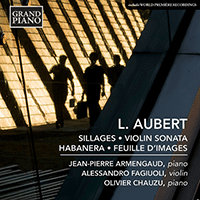
About this Release
ROGER-DUCASSE, JEAN (1873–1954)
Piano Works
- Joel Hastings, piano
Jean Roger-Ducasse was a close friend of Debussy and a composer of considerable reputation in his day, one critic declaring that “all the best qualities of the French musician are combined in him – an abundantly rich imagination, clear and deep thought… and unerring taste.” These qualities are found in piano works that range from exquisitely colourful wartime pieces such as Sonorités, the playfully virtuosic Rythmes, the alternately dreamy and dramatic Barcarolles, to a final, innovative Romance that seems constantly on the brink of wandering away from tonal harmony.
Tracklist
|
1
Barcarolle No. 1 (1906) (00:07:01)
|
|
2
Rythmes (1917) (00:04:56)
|
|
3
Prélude in A Minor (1913) (00:01:44)
|
|
4
Chant de l'aube (1921) (00:04:14)
|
|
5
Sonorités (1918) (00:05:42)
|
|
6 Préludes (1907) (00:10:00 )
|
|
6
No. 1. Très nonchalant (00:01:08)
|
|
7
No. 2. Très calme (00:01:35)
|
|
8
No. 3. D'un rythme très précis (00:01:09)
|
|
9
No. 4. Très libre (00:02:02)
|
|
10
No. 5. D'un rythme capricieux et tendre (00:02:54)
|
|
11
No. 6. Très souple (00:04:04)
|
|
12
Barcarolle No. 2 (1920) (00:09:15)
|
|
13
Impromptu (1921) (00:04:51)
|
|
14
Romance (1923) (00:06:05)
|
|
Petite Suite (arr. J. Charlot for piano 2 hands) (1897) (00:06:29 )
|
|
15
I. Souvenance * (00:02:26)
|
|
16
II. Berceuse * (00:01:58)
|
|
17
III. Claironnerie * (00:02:07)
|
|
4 Études (1915) (00:15:00 )
|
|
18
No. 1. Prélude (00:04:39)
|
|
19
No. 2. Fugue (00:03:35)
|
|
20
No. 3. Lent (00:02:16)
|
|
21
No. 4. Lentement (00:04:47)
|
The Artist(s)
 Joel Hastings’ discography includes live recordings of Franz Liszt’s song and operatic transcriptions and Frederic Chopin’s 24 Etudes. His recordings were selected for Canadian critics’ awards, praised in publications such as American Record Guide and MusicWeb International, and featured on CBC national radio as well as numerous stations throughout the United States. In 2014, the Naxos American Classics label released his recording of solo piano music by American composer Carter Pann [8.559751].
Joel Hastings’ discography includes live recordings of Franz Liszt’s song and operatic transcriptions and Frederic Chopin’s 24 Etudes. His recordings were selected for Canadian critics’ awards, praised in publications such as American Record Guide and MusicWeb International, and featured on CBC national radio as well as numerous stations throughout the United States. In 2014, the Naxos American Classics label released his recording of solo piano music by American composer Carter Pann [8.559751]. The Composer(s)
Reviews

“The late Joel Hastings recorded a fine sampling of Jean Roger-Ducasse’s piano works.” – Fanfare

“The Canadian pianist, Joel Hastings... penetrates deeply into the mysteries of this music, which is supple, complex but never unfathomable.” – Classica
“Hastings has a deft touch and brings a world of piano colors to these selections. There is not an easy piece here. He handles the considerable difficulties with great skill.” – American Record Guide
“Among the most striking pieces here is Rythmes, its shimmering, shifting textures most persuasively coloured by Hastings. The Prelude in A minor is yet another example—and a vivid one too—of French composers’ obsession with all things Spanish, while the second of the Quatre Études is a twinklingly good-natured fugue. Altogether a fascinating snapshot of a composer who was a key figure on the French scene.” – Gramophone






 Grand Piano has gained a reputation for producing high quality recordings of rare keyboard gems. Dedicated to the exploration of undiscovered piano repertoire, the label specialises in complete cycles of piano works by many lesser-known composers, whose output might otherwise have remained unknown and unrecorded.
Grand Piano has gained a reputation for producing high quality recordings of rare keyboard gems. Dedicated to the exploration of undiscovered piano repertoire, the label specialises in complete cycles of piano works by many lesser-known composers, whose output might otherwise have remained unknown and unrecorded.






